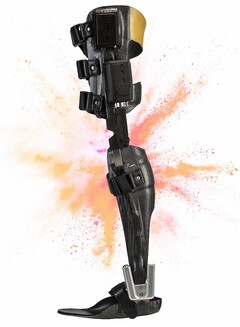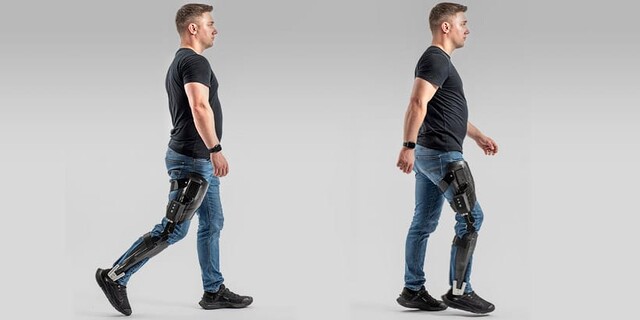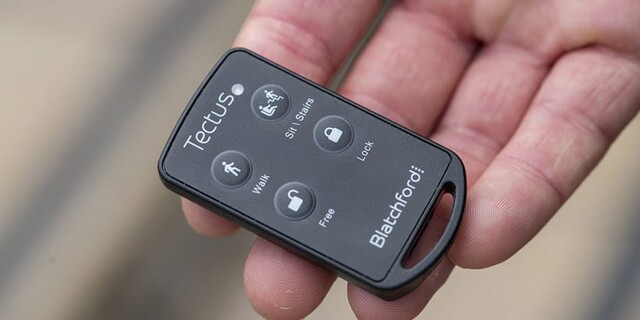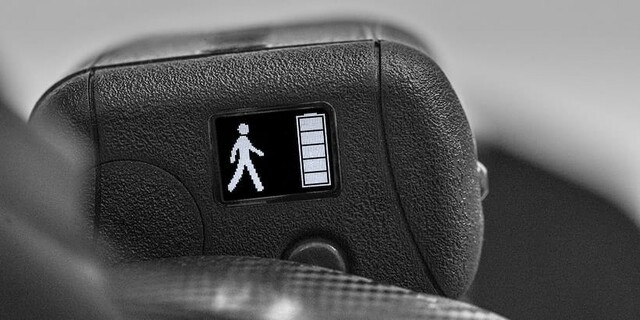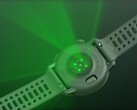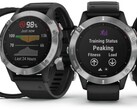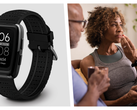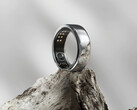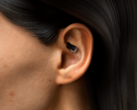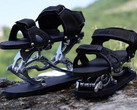Blatchford has announced the availability of their custom-fitted, electronic leg brace, the Tectus. This orthotic contains sensors that monitor a person’s gait, then adjusts the internal springs and hydraulics to help the partially paralyzed leg follow a more normal swing and step. The wearable also helps lift and move the heel so that each step is more stable and safe. By doing so, the Tectus enables wearers to enjoy a greater freedom of motion, range, and speed outdoors while reducing the dependency on canes and wheelchairs.
The Tectus is a 1 lb 7 oz device that is attached to a custom knee, ankle, foot brace, and the unit is IP54 rated to resist dust entry and water splashes during normal activities. The internal battery lasts a full 18 hours of usage and recharges in 2 hours. A digital monitor allows users to check battery status, see step counts, and adjust modes. A remote control also allows users to change modes between various walking speeds, sitting, standing, and descending stairs.
The assistive device is certified for use for people weight between 110 lbs and 220 lbs and can be worn with regular pants and shoes (such as these on Amazon). While the device can aid some patients with leg paralysis due to spinal injuries, muscle weakness, or nerve damage, a physician must verify key physical qualifications are met before use.
Embrace the next step in intelligent orthotics:
Blatchford launch Tectus® - a slim, lightweight microprocessor controlled orthotic device.
16th October 2023:
Blatchford, the world-renowned prosthetics manufacturer, has today launched Tectus®, a life-changing intelligent orthotic device that enables people with partial lower limb paralysis to walk more easily, naturally and comfortably with increased confidence and safety.
A life-changing orthotic device that enables people with partial lower limb paralysis to walk more naturally, comfortably and safely.
At just 660g, Tectus® is the next generation in the development of microprocessor KAFOs (knee, ankle, foot orthoses) thanks to its uniquely small, lightweight and modular design.
Multi-award winning manufacturer Blatchford has leveraged over 130 years of experience in developing advanced prosthetic technology to create Tectus®.
"It feels like you’re using your own leg again," says former British soldier and seated paralympic skier, Alex Slegg.
Tectus® uses Blatchford’s proprietary Performance Response Technology™ (PRT) and award-winning microprocessor-controlled technology to mimic the natural function of the knee joint, resulting in life-changing mobility.
Tectus® attaches to a custom-made KAFO and features a unique, but complex system of spring, hydraulic and sensor technology, allowing wearers to replicate a more natural gait cycle than with any other microprocessor KAFO1. Crucial to this 'biomimicry' is Tectus®'s 'spring assist' feature, which uses an adjustable control to ensure the leg fully extends in a timely manner during the swing phase of walking.
At just 660g, Tectus® is unique for its slim and lightweight design, providing increased comfort which reduces muscle fatigue and energy expenditure1. While the modular design allows for comfortable and flexible positioning of the device, allowing the practitioner to bespoke fit any wearer, irrelevant of thigh shape or size.
The result of all this innovative technology is profound. Tectus® wearers can walk faster, for longer, and with less pain and reduced trips and falls1. And with greater mobility, comes the confidence to embrace everyday pursuits. Users can go from descending stairs to prolonged standing with ease thanks to 5 activity modes, which also enable walking at varying speeds, tackling uneven terrain and controlled smooth sitting. An additional training mode is also included to help practitioners set up and configure the brace.
Finally, Tectus® gives wearers freedom to move on their own terms. Unlike other microprocessor KAFOs, Tectus® allows users to switch between mobility modes on the actual module via a digital display or using a discreet hand held remote control. Battery status, step count and safety warnings are all visible at a glance. Further peace of mind comes from the 18-hour battery life and ability to charge from 0 to 100% in just two hours.
Alex Slegg, Tectus wearer Alex Slegg had the opportunity to test Tectus® before its launch, as part of the product’s clinical evaluation. The British seated paralympic skier and former British soldier was delighted with the results:
“Tectus® was well beyond my expectations. The difference in adding a microprocessor, essentially a computer, to my leg was pretty mind-blowing. There’s nothing else out there like this. It almost feels like you’re using your own leg again. I can descend a set of stairs leg over leg, looking like anyone else, and just as fast as anyone else. In busy environments I don’t feel anxious or feel like I’m going to get knocked over. It’s a great feeling... I finish every day with much more energy than I used to have. I go into every situation with less planning, less anxiety - I can just enjoy the experience."
Alfie Wright, a British para-powerlifter also took part in the Tectus® trials:
"When I first tried the Tectus® I cried, it was like a revolution. All of a sudden I had freedom. It was the best thing in the world. It allows me to walk without crutches. It allows me to be safe. It allows me to do all the things an able-bodied person can do but with this bit of kit on my leg. I can get up slopes. I can walk on grass. I can walk on cobbles. It just gives you that peace of mind that you’re not going to fall and you’re going to be able to walk fluidly." "Tectus® has transformed my life. Before wearing it I was just existing, but now I’m living. And because of the improvements to my physical health, my mental health has improved ten-fold." Alfie Wright - Tectus® wearer
Emma Scowen, Product Manager at Blatchford, said:
"With the launch of Tectus®, Blatchford is moving into a new market where the options are currently very limited for wearers. Stance control products are functional, but they don't give people the freedom to fully embrace daily life. While other microprocessor KAFOs can be considered heavy and bulky, Tectus® has been created to be as minimally unobtrusive and flexible as possible, enabling more comfort and freedom. We’ve taken our world-leading technology in prosthetics and applied it to orthotics, creating a truly life-changing product that can make a difference to so many people globally."




